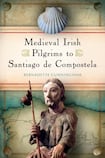
Stephi Schmeichel is writhing on the floor of the albergue, a sausage-like roller under her thigh. She leans all her weight on to it, pushing herself back and forth, cursing not so very softly under her breath, as the device rolls up and down the muscle that’s giving her pain and threatening to make it almost impossible for her to walk any further along the Camino.
Ilona, a tattoo-festooned physiotherapist and masseuse from Latvia and owner of the roller, snaps instructions in her heavily accented English.
“Is good, yes?” she says. “You do more! It work!”
Ira, a slightly shy Finnish woman carrying a great burden of grief she is yet to disclose to her new Camino friends, looks on bemused.
I am the complete outsider, navigating burgeoning new friendships on these, the first few days of another jaunt along the Camino de Santiago de Compostela, my fifth since falling under the spell of this very ancient pilgrimage in 2007.
Before setting out on the Camino in early May from St Jean Pied de Port on the French side of the Pyrenees, I found myself in the company of – weirdly – the Rev Martin O’Kelly, a Church of Ireland curate from Christ Church Bray. Weird because we lived just a few miles apart in north Co Wicklow, but also because it is most unusual for an atheist-minded Protestant like myself to stumble across a real live minister of the Church of Ireland on this most Catholic of journeys.
The rev was tested early. The first day’s walking, a 28km hike over the Pyrenees starting at about 250m above sea level and rising rapidly to 1,400m, is a gruelling trek – something that became apparent to O’Kelly by the time he reached Orisson, the first staging post, a mere 7kms from St Jean.
There, temptation whispered in one ear and he thought to himself: shall I go back to St Jean and take that bus I saw? But grit and determination won through and the rotund priest, a man with a large, warm and ebullient personality to match his girth, soldiered on, reaching Spain and Roncesvalles many hours later (with a little help from a Pyrenean Good Samaritan and a jeep) to rendezvous with his daughter.
Magnetic attraction
The Camino has held a magnetic attraction for millennia and describing it as Catholic is less than the whole story. It is Christian, of course, but the appeal of walking some 800km across northern Spain is a modern echo of the earlier pagan practice of going west, to Finisterre, the end of the earth, where according to pagan lore, the souls of the dead lay with the setting sun.
Thus we walk in the footsteps of ancestors whose pilgrim feet smoothed the stones of the Camino where it is a Roman road outside the village of Cirauqui in Navarra, a route created long before the ninth century “discovery” of the bones of St James the Great, Christ’s favourite disciple, in a place in Galicia known as the field of stars, the campo stella.
Ireland has a long association with pilgrimages to Santiago, in whose great Romanesque cathedral the said bones rest. James is to Spain what Patrick is to Ireland: both brought Christianity to their respective adopted countries, hitherto bastions of paganism, and both are now patron saints. James is celebrated and revered in equal measure across Iberia.
Medieval Irish Pilgrims to Santiago de Compostela by Bernadette Cunningham explores Irish links to Santiago and the lure of the journey, delving into, among other things, such records as exist of several pilgrims from what the author terms 13th-century Anglo Ireland.
There’s Richard de Burgh, Lord of the Manor of Clonmel; Fulk de Sandford, Archbishop of Dublin and formerly a chancellor of St Paul’s Cathedral in London; and William de Vescy, latterly Lord of Kildare – nobles and gentry, people who could afford the cost of both a long and hazardous journey, and of being away from home for a lengthy period.
Their routes to Santiago usually mirrored well-established commercial routes, either directly to northern Spain, preferably to A Coruna and from there the short walk to Santiago, or to nearby regions of France. From these, merchants traded with Irish ports, such as Drogheda, Dublin and Waterford (where pilgrim hostels may have existed for those awaiting embarkation on vessels heading back to home ports), as well as Wexford, New Ross, Youghal, Kinsale, Dingle, Limerick, Galway and Assaroe in Donegal.
Pilgrims hoping to make the voyage often had to linger weeks in Irish ports hoping to catch a vessel going their way. Some had to content themselves hitching a ride to an English port, such as Bristol or Plymouth, before finding a willing ship to take them further south.
Fascinating characters
Just like today, the medieval pilgrims included fascinating characters. Cunningham tells us of George Crissaphan, a Hungarian pilgrim who, disappointed with the apparent lack of austerity in Santiago and Finisterre, and the crowds, decided to go to Ireland.
“Looking for real remoteness, he heard about St Patrick’s Purgatory at the end of the world and set off to walk to Ireland, arriving at his destination at Lough Derg probably in the autumn of 1353,” she writes. “Going on foot was part of his effort to maximise the penitential aspect of the path he had chosen.”
Crissaphan was rewarded with the hospitality in Ireland of the primate, Richard FitzRalph, the local kings of Ulster and no less than Edward III, king of England.
Cunningham’s book is a scholarly work, replete with exhaustive footnotes and detailed explanatory references. It is also very readable and is a rich contribution to the subject for anyone interested in the Camino and who wants to dive deeper into its past.
In that regard, the appeal to religiously motivated Irish people 500 and more years ago remains the same today – the attraction of the notion of eternal salvation, or having to spend less time in Purgatory, and of connecting somehow with an Almighty through proximity to relics of a great saint.
Cunningham concludes by noting that the Irish medieval experience of the journey to Santiago shows how much this seafaring nation was connected in the Middle Ages to mainstream European spirituality. Today, the appeal of the Camino is wonderfully broad, attracting people from all over the world, but especially from Europe – less for conventional religious reasons than for experiencing a sense of spirituality, of engaging with nature and the seemingly contradictory notions of solitude and sharing time with others.
As medieval Irish pilgrims appear to have found, the Camino is, above all else, a tremendously enriching human experience.
Stephi’s leg muscles improved with Ilona’s expert help and Ira found, if not herself, then a large measure of peace of mind. All three walked into Santiago and now have their eyes fixed on Croagh Patrick. . . The Rev O’Kelly has just been installed as rector of his own first parish in Kingscourt, Co Cavan, while his daughter is helping run a restaurant in Hornillos, on the Camino near Burgos.
Peter Murtagh is co-author, with Natasha Murtagh, of Buen Camino, a father daughter journey from Croagh Patrick to Santiago de Compostela; Gill and Macmillan, 2011












